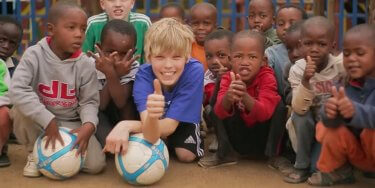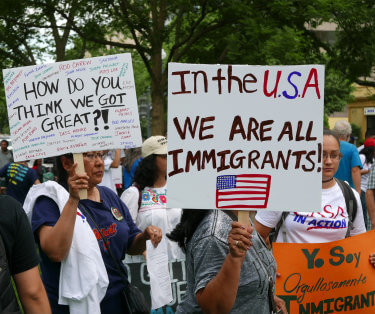SHAPE America’s 50 Million Strong by 2029 commitment challenges each one of us to contribute to getting all of America’s children physically active, enthusiastic, and committed to making healthy lifestyle choices (SHAPE America, 2017). Of the approximately 50 million students presently attending America’s public schools, approximately 23 percent are estimated to be from immigrant and refugee backgrounds (Center for Immigration Studies, 2017). These young people face a myriad of challenges as they adapt to American culture. This includes navigating language, cultural barriers, stereotypes, along with negative attitudes regarding their residence and matriculation to the United States (National Center for Educational Statistics, 2017). With these students in mind, the following three considerations can help us meet our goal of improving the lives of all children regardless of race, gender, religion, or financial circumstances.

Get Educated
America, has a complex history regarding immigration and the treatment of immigrants. It’s a history that is politicized and routinely distorted (Culp, 2017). Data from the 2016 Current Population Survey (CPS) reported that immigrants and their U.S. born children number approximately 84.3 million people – nearly one-third percent of the overall U.S. population. Mexicans are the largest group of current immigrants in the country at 27%. Newer immigrants are largely represented from India (6%), China and the Philippines (5% each), El Salvador, Vietnam and Cuba (3% each), and the Dominican Republic, Korea, and Guatemala (2% each). Immigrants from these ten countries constitute roughly 60% of the U.S. immigration population. Other places of origin for immigrants in smaller percentages include Ireland (Northern Europe), France (Western Europe), Greece and Spain (Southern Europe), as well as Romania, Russia, Ukraine, and Bosnia (Eastern Europe).
Immigrants and refugees are often inaccurately perceived to be members of the same group. Generally, an immigrant is a non-native person who chooses permanent residence in a foreign country and has obtained the legal right to seek citizenship and take up employment. In contrast, a refugee is an individual who has been forced to flee his or her home country because of threat of war or persecution (United States Department of Homeland Security, 2017). Other designations include undocumented immigrants (who do not seek legal status for residency), asylees (people who meet the definition of a refugee and are already present in the United States not looking to return to their home country), and individuals who have been forcibly displaced (for reasons including population transfer, natural disaster, ethnic cleansing, deportation).

Site Check
Places have meaning and significance for all of us, but this is especially true for children and youth. Accentuating positive behaviors in the physical and health education environment is valuable for immigrant and refugee children. Immigrant youth may feel discomfort, helplessness, frustration, fear, insecurity, uncertainty on how to behave, and anxieties regarding communication. For refugees, these feelings are sometimes magnified together with culture shock, survivor’s guilt, self-doubt, anger, fatigue, hunger, fear of victimization, and other traumas. Four initial questions all teachers with immigrant or refugee students in their classes should ask themselves include: (1) Are my rules and protocols consistent? (2) Do I have a gym, classroom, or activity area environment that feels inclusive with images, signs, and slogans where students feel a sense of ownership? (3) Do I incorporate culturally responsive lessons and curriculum? and (4) Am I comfortable in my role as a model for the behaviors I want transmitted to my students?

Outreach and Support
Physical and health educators are routinely asked to go “above and beyond” their assigned duties. Many of us serve additional “unofficial roles” such as counselors, psychologists, life coaches, and motivators. Making a difference in the lives of others invokes empathy; we imagine ourselves in someone else’s shoes and become determined to quickly find solutions to problems. Teachers who serve immigrant and refugee students must frequently navigate through a host of emotions such as guilt, pity, idealization, dread and horror, personal vulnerability, and avoidance reactions. Vicarious traumatization, also called compassion fatigue is associated with the “cost of caring” for others and can impact a teacher’s personal life and relationships (Baird & Kracen, 2006). To effectively help students, teachers should develop a strategy that engages families and community supports such as interpreters, religious leaders, immigration lawyers, health services, universities, and as applicable, corporate and governmental organizations.
Conclusion
In summary, remembering these three considerations when addressing the needs of immigrant and refugee children is a good starting point for all teachers. But in reality, it’s just a sampling of adaptive strategies physical and health educators can incorporate into their teaching. In the quest to foster an “active, alert, engaged, healthy, and globally minded citizenry” (Cardinal, 2016, p. 56), physical and health education must become more diverse in scope and expand existing models to create success stories. We have the capability to be transformative. Let us not forget that in our world, change is constant and what could be perceived as a challenge is a unique opportunity to inspire our profession to new heights.
(Publishers Note: This article is based on a presentation made by the author as part of the 50 Million Strong by 2029 Forum held at the 2017 SHAPE America National Convention.)
References
Baird, K., & Kracen, A. C. (2006). Vicarious traumatization and secondary traumatic stress: A research synthesis. Counselling Psychology Quarterly, 19(2), 181-188.
Cardinal, B. J. (2016). Toward a greater understanding of the syndemic nature of hypokinetic diseases. Journal of Exercise Science & Fitness, 14(2), 54-59. doi: http://dx.doi.org/10.1016/j.jesf.2016.07.001
Center for Immigration Studies (2017). Mapping the Impact of Immigration on Public Schools. Accessed 9/18/17 at https://cis.org/Report/Mapping-Impact-Immigration-Public-Schools
Culp, B. (2017). “Illegitimate” bodies in legitimate times: Life, liberty, and the pursuit of movement. Quest, 1-14. doi:10.1080/00336297.2017.1287578
National Center for Education Statistics (2017). Fast Facts. Accessed 9/18/17 at https://nces.ed.gov/fastfacts/display.asp?id=372
Society for Health and Physical Education (2017). 50 million strong by 2029. Accessed 3/28/17 at http://50million.shapeamerica.org/about-us/
United States Department of Homeland Security (2015). Yearbook of immigration statistics. Accessed 2/25/17 at https://www.dhs.gov/immigration-statistics/yearbook/2015
